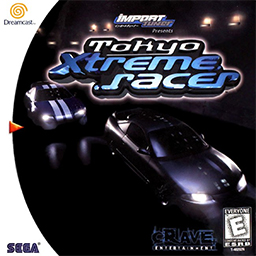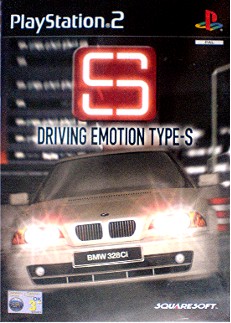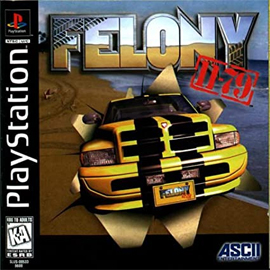Racing games are a video game genre in which the player participates in a racing competition. They may be based on anything from real-world racing leagues to fantastical settings. They are distributed along a spectrum between more realistic racing simulations and more fantastical arcade-style racing games. Kart racing games emerged in the 1990s as a popular sub-genre of the latter. Racing games may also fall under the category of sports video games.

Metropolis Street Racer (MSR) is a racing video game developed by Bizarre Creations and published by Sega exclusively for the Dreamcast. Initially intended as a launch title for the Dreamcast, its release in Europe was delayed until November 2000, with a North American version following in January 2001. A Japanese version was anticipated by February 22, 2001, but was ultimately canceled after Sega discontinued support for the Dreamcast.

Gran Turismo 4 is a 2004 racing simulation video game developed by Polyphony Digital and published by Sony Computer Entertainment for the PlayStation 2. It is the fourth main installment and the sixth overall in the Gran Turismo series. It was released on December 28, 2004, in Japan and Hong Kong, February 22, 2005, in North America, and March 9, 2005, in Europe, and has since been re-issued under Sony's Greatest Hits brand.

18 Wheeler: American Pro Trucker, known in Japan as 18 Wheeler, is an arcade game developed by Sega AM2 and distributed by Sega. The game was released in arcades in 1999 and ported to the Dreamcast in 2000. It was released for the PlayStation 2 in 2001 and GameCube in 2002 by Acclaim Entertainment. Sega followed up on the success of 18 Wheeler with a sequel, The King of Route 66, which was released in the arcades in 2002 and ported to the PlayStation 2. This was one of the final arcade games to be ported to the Dreamcast after its discontinuation, before Sega became a third-party developer.

F355 Challenge is a 1999 racing simulation arcade video game based on the race car and Ferrari event. It was developed by the AM2 division of Sega for the Sega Naomi Multiboard arcade system board under the direction of Yu Suzuki, and was later ported to the Dreamcast and PlayStation 2 home video game consoles under the names F355 Challenge: Passione Rossa and Ferrari F355 Challenge respectively for both American and European releases. The only model of car featured in the game is the Ferrari F355 Challenge model. Unlike Sega's other arcade racers like Out Run titles, F355 Challenge aimed to be realistic. The game was considered the most accurate simulation of the F355 possible up until that time.

Ace Combat 2 is a 1997 combat flight simulation video game developed and published by Namco for the PlayStation. It is the sequel to Air Combat and the second in the Ace Combat franchise. The player controls one of 24 different fighter jets through 21 different missions with certain objectives to fulfill, such as protecting a base from enemy fire, intercepting a squadron of enemies, or taking down an aircraft carrier.

R4: Ridge Racer Type 4, released without the 'R4' prefix in PAL territories, is a 1998 racing video game developed and published by Namco for the PlayStation. It is the fourth home title in the Ridge Racer series after Rage Racer (1996) and was initially released on December 3, 1998 in Japan, with global releases following in 1999.
Rush is a series of racing video games developed by American-based company Atari Games and published by Atari Games and Midway Games for home consoles. The series debuted worldwide in 1996. The games consist mainly of racing with various cars on various tracks while players perform stunts in races.

Tokyo Xtreme Racer, known as Shutokō Battle in Japan and Tokyo Highway Challenge in Europe, is a 1999 racing video game by Genki, for Sega's Dreamcast console. Released as a launch title in the West, the game was one of the first mission-based racing games; it is based on illegal highway racing in Tokyo's Wangan highway with custom tuned cars. It was the second title in the Shutoku Battle/Tokyo Xtreme Racer series to be released in the West following Tokyo Highway Battle (1996).

F1 Grand Prix is a racing video game developed by Traveller's Tales and published by Sony Computer Entertainment exclusively for PlayStation Portable.
Gihren's Greed, is a series of turn-based strategy video games produced by Bandai, based on the Gundam franchise. It takes its gameplay style from the SD Gundam series and adds political and military management to the One Year War. The Japanese title, Giren no Yabō, is derived from that of Nobunaga's Ambition, although the English title uses a different translation for the word yabō.

Sega Bass Fishing, known in Japan as Get Bass, is an arcade fishing video game developed in 1997 by Sega for the Sega Model 3 hardware. The game has since been ported to the Dreamcast, Microsoft Windows, Xbox 360, PlayStation 3 and Wii.

AeroWings, known in Japan as Aero Dancing featuring Blue Impulse, is a flight simulator for Sega's Dreamcast video game console. The player can train with squads, learn the ropes of handling the aircraft, and doing tricks after mastering the different stunts.
A number of video games have been made of Le Mans 24 Hours. The race, the Circuit de la Sarthe, and competing cars have been featured in racing games such as the Gran Turismo series.

Super Robot Taisen Alpha, known as Super Robot Wars Alpha outside Japan, is a 2000 tactical role-playing video game developed and published by Banpresto for the PlayStation. A version for the Dreamcast, Super Robot Wars for Dreamcast, was released a year later.

Driving Emotion Type-S is a racing game developed by Escape, a subsidiary of Square. It was published in Japan on March 30, 2000 and was Square's first release for the PlayStation 2 console. After criticisms of the game's handling, the international versions feature revised controls and additional contents, and were released in January 2001.
Climax Entertainment was a Japanese video game development company. It was a small company, with just 20 staff in 1996. Climax got its start during the 16-bit era, primarily developing games for the Sega Genesis console. During the 32-bit era, some members of the team left to create Matrix Software. Following the development of Dark Savior (1996), a group of staff members from the company's CGI division formed an independent company Climax Graphics, initially described as a "brother company".

Felony 11-79, known in Japan as Runabout, is a video game developed by Climax and published by Yanoman and ASCII for the PlayStation in 1997. It was part of a late 1990s wave of driving games which encourage the player to create chaos and destruction, being preceded by Die Hard Trilogy and Carmageddon. A sequel to the game, called Super Runabout: San Francisco Edition, was released in 2000.

E.X. Troopers, stylized as E.X. Tr∞pers, is a third-person shooter video game developed and published by Capcom for Nintendo 3DS and PlayStation 3. It is a spin-off of the Lost Planet series. The game was released in Japan to retail customers on November 22, 2012 and later on Nintendo eShop and PlayStation Network on January 24, 2013.

Super Runabout: San Francisco Edition, known in Europe as Super Runabout: The Golden State, is a video game developed by Climax Entertainment for the Dreamcast in 2000. It is the sequel to the PlayStation game Felony 11-79, which was known in Japan as Runabout.













